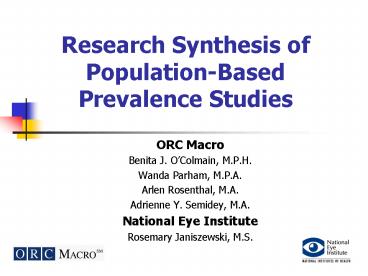Research Synthesis of Population-Based Prevalence Studies - PowerPoint PPT Presentation
Title:
Research Synthesis of Population-Based Prevalence Studies
Description:
Age-related macular degeneration. Diabetic retinopathy. Glaucoma. Cataracts ... Completed meta-analysis for age-related macular degeneration ... – PowerPoint PPT presentation
Number of Views:45
Avg rating:3.0/5.0
Title: Research Synthesis of Population-Based Prevalence Studies
1
Research Synthesis of Population-Based Prevalence
Studies
- ORC Macro
- Benita J. OColmain, M.P.H.
- Wanda Parham, M.P.A.
- Arlen Rosenthal, M.A.
- Adrienne Y. Semidey, M.A.
- National Eye Institute
- Rosemary Janiszewski, M.S.
2
Research Synthesis
- Synthesis of research findings offers the
potential to - Identify areas of agreement
- Increase statistical power
- Identify areas needing more research
- Fosters a greater sensitivity to the currently
available scientific evidence
3
Purposes of Research Synthesis
- State-of-the-art literature review
- Presents and analyzes available data, framing
results so they can be translated into practice
and policy - Logical framework for systematic and objective
review of data (scientific results) - Establish what is known prior to further research
4
Research Synthesis Essential Steps
- Specification of objectives, hypotheses, scope,
and methods of systematic review - Compilation of a comprehensive set of relevant
primary studies - Assessment of the methodological quality of the
studies - Identification of a common set of definitions of
outcome, explanatory and confounding variables - Extraction of a standardized set of outcome
measures and of study subjects and
characteristics
5
Meta-analysis
- Subset of research synthesis
- Statistical analysis of a large collection of
analysis results from individual studies for the
purpose of integrating the findings (Glass, 1976) - May produce more generalizable results
- Helps to explore variation between studies and
assess factors which might modify effects
6
Purposes of Meta-analysis
- Statistical methods for combining results
- Fixed vs. random effects models
- Gain in statistical power for estimates
- Reduces the effect of random error
- More precise summary estimate
- Resolve issues related to conflicting results
from studies - Formal/informal models for heterogeneity
7
Meta-analysis Essential Steps
- Use appropriate and clearly stated models
- Explore and allow for all important sources of
variation - Report confidence intervals for pooled estimates
- Evaluate tests of heterogeneity
- Clear presentation of results to enable critical
appraisal and replication
8
(No Transcript)
9
Guiding Principles
- In a research synthesis/meta-analysis, individual
study results are the raw data - Systematic reviews are retrospective
observational studies and thus are potentially
subject to the same biases as other retrospective
observational studies - Need an a priori protocol for data selection and
analysis
10
Population-Based Epidemiological Eye Studies
- Conducted over the past 20 years
- Framingham, 1980
- Assess prevalence of eye disease based on results
of clinical examinations - Evaluate vision impairment and blindness
- Study risk factors associated with eye disease
11
Objectives of Research Synthesis of
Population-Based Eye Studies
- Estimate prevalence of blindness and visual
impairment (all cause) - Estimate prevalence of
- Age-related macular degeneration
- Diabetic retinopathy
- Glaucoma
- Cataracts
- Refractive error (myopia and hyperopia)
- Estimate attributable blindness and visual
impairment due to these diseases
12
Methodological Approach Research Synthesis
- Literature review
- Identify appropriate studies for each disease
- Determine inclusion/exclusion criteria
- Review case definitions for each disease
- Develop consistent criteria across studies
- Use uniform age categories for prevalence
estimates (5 year CDC standard)
13
Preliminary List of Studies
14
Methodological ApproachMeta-analysis
- Obtain raw prevalence data from each study
according to standardized case definitions and
uniform age groups - Determine appropriate models
- Review graphical and statistical output
- Collapse cells where data is sparse
- Assess heterogeneity
15
Current Status
- Completed meta-analysis for age-related macular
degeneration - Derived age-specific prevalence rates
- Geographic and neovascular AMD
- Drusen gt125
- Blindness due to AMD
- Meta-analysis for diabetic retinopathy in
progress
16
Next Steps
- Complete meta-analysis for other diseases
- Determine current burden of
- Each disease
- National and State level by race and gender
- Blindness and vision loss due to each disease
- Future projections
- Publish results































